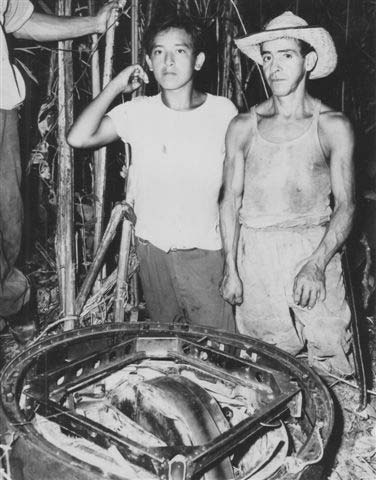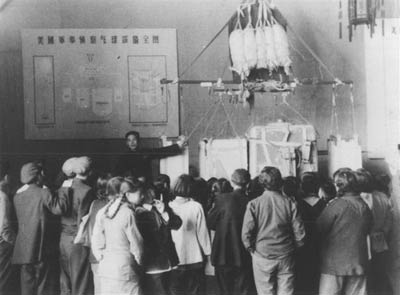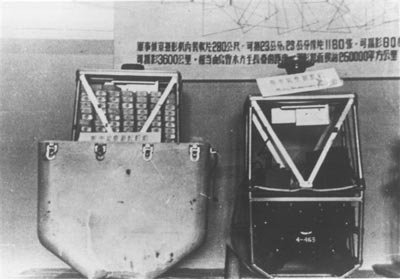
Spysat down!by Dwayne A. Day
|
| USA 193 is not the first time that a US reconnaissance satellite has come down in an unplanned manner and caused intense embarrassment. |
The launch of the April 1964 mission, labeled number 1005, was uneventful. But after 350 camera operations the film for the “slave” camera—the panoramic camera located in the forward part of the vehicle—broke. Shortly afterward, the Agena power supply failed. On April 30, ground controllers ordered the spacecraft to eject its first SRV for reentry on southbound revolution number 47. The vehicle verified receipt of the command, but did not carry it out. Various ground stations repeatedly sent commands to the satellite on 26 subsequent passes through May 20. On May 19 the vehicle no longer acknowledged the receipt of the commands. Ground controllers assumed that the vehicle was headed for an uncontrolled reentry and would burn up, as had other spacecraft.
The US satellite tracking network kept close watch on the capsule. Early calculations of its decay rate led to a prediction that it would impact in the Pacific, west of the coast of South America and about 10 degrees north of the South Pole—far from inhabited land. But later calculations based upon better orbital trace measurements indicated that the capsule would probably come down somewhere in Venezuela. Observation stations in the Caribbean were alerted to watch the skies on May 26, the anticipated date of reentry. At six minutes after midnight, on northbound orbit number 452, observers in Maracaibo, Venezuela reported five bright objects passing overhead, heading for the South American coast and presumably the ocean. Nearly six weeks later, the two farm workers stumbled upon the wreckage.
When Leonardo Davilla called the U.S. embassy on August 1 and spoke to the Army attaché, he apparently was not very convincing, because the Army officer initially did nothing. But Davilla called back on the following Monday. The Army attaché then called the embassy’s Air attaché to notify him of what Davilla had said. The two officers were unable to find an aircraft to take them to Facundo Albarracin’s farm. On Tuesday they interviewed a commercial pilot who had seen the object and had returned to Caracas with a souvenir piece. The Army attaché flew to La Fria, the village nearest to where the object had reportedly been found. But when he arrived, he learned that the Venezuelan army had arrived first and had taken it to San Cristobal, the provincial capital. He then headed to San Cristobal, where he examined it himself.
 Farmers in Venezuela recovered part of a classified American reconnaissance satellite in 1964. (credit: NRO) |
The capsule was not in good shape. It had been heavily damaged in the impact. Even worse, in the three weeks since it had been found, local farmers had hacked away at its skin. They had noticed a gold disc attached to the upper section of the capsule. This disc, made of real gold, was used as a heat dispersion mechanism during reentry. As this and other discs melted, they sheathed the capsule in foil-thick pure gold. The farmers had hacked at the vehicle looking for more of the discs. Various passerby had also removed pieces, and the farmer whose ranch the vehicle had landed on reportedly gave the strobe beacon light to one of his children as a toy. One farmer had used the parachute lines as a harness for his horse.
The Army attaché also found an American nickel and a quarter in the wreckage. On at least one previous mission coins had been found hidden inside a recovered reconnaissance capsule and the Air Force had issued an injunction against such practices. Obviously the injunction was being ignored. In addition to the coins, the attaché reported finding the film that remained in the bucket. He described it as “well-cooked.”
The Venezuelan army ignored the American Army officer’s request to release the object to US authorities. The Venezuelan army, with the American in tow, flew the wreckage to Caracas and promised to deliver it to the Americans on the following day, Friday, August 6. But when the object reached Caracas, it was taken directly to the office of the Venezuelan Minister of Defense. It did not return to American hands until Tuesday, August 10. Apparently, the United States had to buy back its spacecraft from the Venezuelans, but not before the Minister of Defense apparently decided to keep the radio transmitter beacon as a souvenir.
By this time Air Force officers attached to the CIA had arrived in Caracas to retrieve the object. They reported that the impact and souvenir-hunters “have pretty well reduced internal equipment to junk.” The impact had compressed the capsule to about two-thirds of its original length. The spooled film was beyond salvage. Part of the ablator was missing, along with most of the parachute cover, the parachute (which had not deployed), the thrust cone, the rocket motor, and all but one of the gold discs.
| In the laconic words of the Director of the NRO, the experience “provided valuable engineering data on non-optimum re-entry survivability.” |
By now many people knew about or had seen the top secret equipment. But what was worse was that the story had spread beyond the people associated with the object’s recovery. On August 4, the local Reuters correspondent had reported the find in a dispatch that was picked up by several wire services. The story appeared in the Washington Star and the New York Times on August 5, before the capsule was even back in American hands. Photos appeared in the San Cristobal newspaper, Diario Catolico, clearly showing the film-takeup reels inside the battered capsule. One reel was full, the other nearly empty. To a trained eye, these would be rather obvious indicators of the presence of a camera.
In the laconic words of the Director of the National Reconnaissance Office, the experience “provided valuable engineering data on non-optimum re-entry survivability.”
If the efforts to retrieve the capsule in Venezuela had been somewhat comical, the comedy was not about to end. The recovered capsule was shipped to Lockheed’s Advanced Projects facility in Palo Alto, California via a “secure air route,” probably involving one of the CIA’s murky airline operations.
But this was not sufficient for the spooks, who also created a dummy package that they would ship via normal military transportation back to the United States. The dummy package was a crate filled with paper, pieces of wood, and scrap metal. It was addressed for shipment to the home of a Defense Intelligence Agency officer assigned to the Pentagon. But the shipping manifest declared that the cargo weighed 250 pounds when it actually weighed only 80 pounds. When the cargo reached McGuire Air Force Base the weight discrepancy was noticed by customs officials, who assumed that they had intercepted a drug shipment. They opened the carton and found only the inexplicable junk, shipped at considerable expense back to the United States. They contacted the addressee and informed him that they were “going to investigate.” The officer stalled them and made a frantic call to the CIA to “cut this one off.” The CIA, through its contacts with the Customs Bureau, retrieved and destroyed the box six days later. Another, albeit minor, breach of security was averted.
The CORONA operations team evaluated the causes for the Agena and camera problems and attempted to fix them. When the battered capsule finally reached Lockheed in Palo Alto, it was carefully examined by the CORONA team. They evaluated it and recommended several changes pertaining to future reentry vehicles. First, all classification markings were removed from orbital CORONA vehicles before launch; objects clearly labeled “Secret” were likely to draw unwanted attention if recovered. Second, a new label was substituted offering, in eight languages, a “reward for return to American authorities” of the recovered part. Finally, vehicle inspection procedures were reinforced to protect against the stowage of more souvenirs during fabrication and checkout.
This event represented the most serious breach of security during the entire CORONA program, but it was not the only one. In 1959 a Discoverer reentry vehicle—without any classified material aboard—had reportedly come down on Spitzbergen Island in the Arctic Circle. Air Force officers raced to the scene, but did not locate the craft and they suspected that the Soviet Union might have retrieved it. This incident formed the basis for the novel and later movie Ice Station Zebra. However, neither the Soviet Union nor the later Russian government has ever confirmed that they retrieved a capsule. More to the point, a key Air Force official involved in the launch doubted that it was ever recovered. He noted that it was highly unlikely that the vehicle could have come down and hit the only bit of dry land amid millions of square kilometers of ocean.
| Thereafter all classification markings were removed from orbital CORONA vehicles before launch; objects clearly labeled “Secret” were likely to draw unwanted attention if recovered. |
In the 1990s Sergei Khrushchev, the son of Nikita Khrushchev and himself a former Soviet aerospace engineer, claimed that in the 1960s the Soviet Union had retrieved parts from several American reconnaissance satellites and that in one case some film had been recovered by peasants who used it to cover their house. However, it seems far more likely that if any materials or film were actually recovered, they came from some of the hundreds of spy balloons that the United States had floated over the Soviet Union in the 1950s, most of which were shot down or fell somewhere in the vast Soviet arctic.
  Chinese propaganda photos of recovered American spy balloon equipment. Hundreds of these classified balloons with their high tech camera equipment came down in the Soviet Union and China in the 1950s and some were recovered. (credit: NRO) |
Declassified National Reconnaissance Office records refer to only one other incident besides the Venezuelan caper. Apparently, pieces of a reconnaissance satellite were recovered in England in the 1960s, although not properly identified until later.
There may have been other incidents of classified American satellites falling to the ground and being recovered, but they have never been made public—something that many in the National Reconnaissance Office certainly wish had been the case with USA 193.